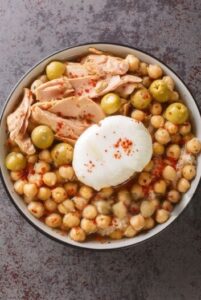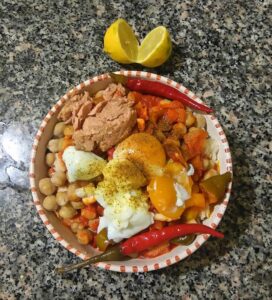Table of Contents
- What is Lablabi? History and Origins
- The necessary ingredients to prepare lablabi
- The step-by-step preparation of the traditional recipe
- Variations and additions to the basic recipe
- Tips for serving and best enjoying lablabi
- Nutritional values and health benefits
- Lablabi in Tunisian culture
- Conclusions and final thoughts
- FAQs
Lablabi is a traditional Tunisian chickpea soup, which represents not only a typical dish of the local cuisine but also a symbol of the country’s gastronomic culture. The origins of this dish date back centuries, when chickpeas were one of the staple foods for the populations of North Africa. This dish is often associated with “cucina povera” (poor man’s cooking), as its ingredients are simple and readily available.
However, its preparation and consumption have become a ritual that transcends social classes, making it a dish loved by all. Throughout history, lablabi has undergone various culinary influences, thanks to the numerous cultural exchanges that have characterized Tunisia. Merchants and travelers crossing the Mediterranean brought with them spices and cooking techniques, enriching the original recipe.
Today, lablabi is a dish found in every corner of Tunisia, from street food stalls to the most refined restaurants, and is often served during holidays and family celebrations.
Summary
- Lablabi is a traditional Tunisian soup based on chickpeas, spices, and bread
- The necessary ingredients to prepare lablabi include chickpeas, olive oil, garlic, stale bread, and spices like cumin and paprika
- The traditional recipe involves preparing the chickpeas in broth, adding spices, and serving with stale bread
- Variations and additions to the basic lablabi recipe can include the addition of hard-boiled eggs, canned tuna, or sausage
- To best enjoy lablabi, it is recommended to serve it hot, seasoned with olive oil and accompanied by toasted bread
The necessary ingredients to prepare lablabi
To prepare a delicious lablabi, it is essential to have fresh, high-quality ingredients. Chickpeas are the main element and can be used either dried or canned. If you opt for dried chickpeas, it is advisable to soak them for at least 12 hours before cooking to reduce preparation time and improve their digestibility.
In addition to chickpeas, the traditional recipe calls for vegetable broth or water, which will serve as the base for the soup. Other essential ingredients include cumin, a spice that gives a characteristic flavor to lablabi, and harissa, a spicy chili paste that adds a touch of vibrancy to the dish. Furthermore, it is common to add minced garlic, lemon juice, and olive oil to further enhance the flavors.
Finally, to garnish the soup, you can use croutons of stale bread and freshly chopped parsley.
The step-by-step preparation of the traditional recipe

The preparation of lablabi requires a few fundamental steps that guarantee a final result rich in flavor. Initially, if using dried chickpeas, it is necessary to drain them after soaking and rinse them well. Subsequently, in a large pot, sauté the minced garlic in a drizzle of olive oil until it turns golden.
At this point, you can add the chickpeas and stir well to let them absorb the flavor. After a few minutes, pour the vegetable broth or water into the pot and bring it to a boil. Once it reaches a boil, reduce the heat and let it simmer for about 45 minutes or until the chickpeas are tender.
During cooking, it is important to stir from time to time and add water if necessary to prevent the soup from drying out too much. At the end of cooking, add the cumin and harissa, mixing well to combine the flavors.
Variations and additions to the basic lablabi recipe
Although the traditional lablabi recipe is already delicious as it is, there are numerous variations that can further enrich the dish. One of the most common additions is vegetables, such as carrots or zucchini, which can be cooked with the chickpeas to give more substance to the soup. Some chefs also prefer to add fresh tomatoes or tomato puree to give a touch of acidity and color.
Another interesting variation is the addition of meat, such as chicken or lamb, which can be cooked with the chickpeas to create a more substantial and nutritious soup. In some regions of Tunisia, it is common to serve lablabi with sliced hard-boiled eggs on top of the soup, creating a contrast of textures and flavors. Finally, for those who love spicy food, it is possible to increase the amount of harissa or add fresh chili peppers during cooking.
Tips for serving and best enjoying lablabi
Serving lablabi in the right way can make all the difference in the overall culinary experience. Traditionally, the soup is served in deep bowls accompanied by croutons of stale bread or a Tunisian bread called “tabouna.” The croutons can be dipped directly into the soup or served on the side to allow each diner to decide how much bread to add.
To further enhance the flavors of lablabi, it is advisable to garnish the dish with a drizzle of extra virgin olive oil and a sprinkle of freshly chopped parsley. Some also prefer to add a splash of fresh lemon juice before enjoying the soup, as the acidity of the lemon perfectly balances the flavor of the chickpeas and spices. Finally, it is important to enjoy lablabi slowly, appreciating every bite and letting the flavors blend on the palate.
Nutritional values and health benefits of chickpea soup

The benefits of proteins and minerals
Chickpeas are an excellent source of plant-based proteins, dietary fiber, and various minerals such as iron, magnesium, and zinc. These nutrients contribute to a balanced diet and can help maintain stable blood sugar levels.
The benefits of fiber and olive oil
Furthermore, the fiber present in chickpeas promotes digestive health and can help reduce the risk of heart disease. The use of olive oil in the preparation of lablabi provides additional health benefits. Olive oil is known for its anti-inflammatory and antioxidant properties and is associated with a reduced risk of chronic diseases such as diabetes and cardiovascular disease.
The benefits of spices
Finally, spices like cumin and harissa not only enrich the flavor of the soup but can also have positive effects on digestion and metabolism.
Lablabi in Tunisian culture: festivities and traditions linked to this dish
Lablabi holds a special place in Tunisian culture and is often associated with moments of conviviality and celebration. During religious holidays like Ramadan, this dish is frequently consumed as the evening meal after fasting. Its preparation becomes a moment of sharing among family and friends, creating bonds through food.
Furthermore, during national celebrations or gastronomic fairs, lablabi is often presented as a symbol of Tunisian culinary identity. Regional variations may differ slightly in preparation or ingredients used, but all maintain the essence of the original dish. This link between food and culture makes lablabi not just a meal but also a social experience that reflects local traditions.
Conclusions and final thoughts on lablabi as a traditional Tunisian dish
Lablabi represents much more than a simple soup; it is a symbol of Tunisian culture that encapsulates stories of tradition and conviviality. Its preparation requires attention to detail and a passion for fresh ingredients, making it a dish that can be appreciated by everyone. Its variations offer endless creative possibilities in the kitchen, allowing everyone to customize the recipe according to their own tastes.
Furthermore, the nutritional benefits of lablabi make it a healthy and satisfying option for those seeking a balanced meal. Its presence in festivities and celebrations underscores the importance of food as an element of social cohesion in Tunisian culture. Ultimately, savoring a bowl of lablabi means immersing oneself in a culinary tradition rich in history and meaning.
FAQs
What is Lablabi?
Lablabi is a traditional Tunisian soup made from chickpeas and spices, often served with bread and condiments.
How is Lablabi prepared?
The traditional Lablabi recipe involves cooking chickpeas in water with garlic, cumin, and olive oil. It is then served with bread, olive oil, hard-boiled eggs, and condiments like capers and olives.
What type of bread is used for Lablabi?
The bread traditionally used for Lablabi is Tunisian bread, called “tabouna“, but it can be replaced with pita bread or whole wheat bread.
What are the typical condiments for Lablabi?
Typical condiments for Lablabi include olive oil, hard-boiled eggs, capers, olives, black pepper, and harissa, a spicy chili paste.
What is the origin of Lablabi?
Lablabi has Tunisian origins and is considered a traditional dish of the country’s cuisine. It is often consumed as a breakfast or snack.





